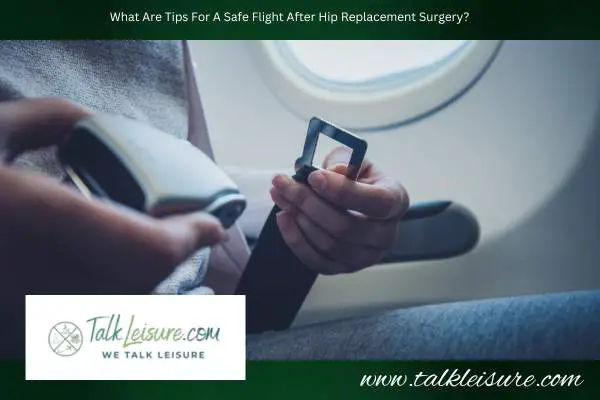Are you eagerly waiting to hop on a plane and fly off to your dream vacation destination after your hip replacement surgery?
Before you book your tickets, it’s crucial to understand the dos and don’ts of flying after surgery.
No doubt, traveling can significantly impact your recovery, and it’s crucial to follow the proper guidelines to ensure your safety and comfort.
This blog post discusses when it’s safe to fly after hip replacement surgery, what precautions to take, and how to manage travel anxiety.
If you are planning to travel after undergoing hip replacement surgery, knowing when it is safe to take a flight is essential.
The timing of flying after hip replacement surgery can vary depending on factors such as your overall health, the type of flight you are taking, and your surgeon’s advice.
In general, it is advisable to postpone non-urgent travel until you can walk comfortably without crutches and your surgical wound is fully healed (usually 7–10 days after surgery).
After this period, short flights (less than 3–4 hours) can be taken relatively soon after surgery, whereas longer flights (greater than 4 hours) should be avoided for at least four weeks after surgery.
To minimize risks and ensure a safe flight after hip replacement, it is recommended that patients obtain additional legroom, take walk breaks during the flight, keep themselves hydrated, and perform calf exercises.
What Is Hip Replacement Surgery?

This procedure is also known as total hip arthroplasty.
It’s usually recommended for patients with severe hip pain or difficulty walking due to arthritis or injury.
The artificial joint comprises a ball and socket joint consisting of a metal ball and plastic socket that fit together to form a new hip joint.
Depending on the patient’s age and activity level, this joint can last up to 20 years or more.
Hip replacement surgery is typically performed under anesthesia and takes a few hours.
After surgery, patients must stay in the hospital for a few days and undergo physical therapy to help restore full mobility.
The recovery period can take several weeks or months, but with proper care, patients can regain mobility and return to normal activities.
When Can You Fly After A Hip Replacement?

Hip replacement surgery is long and sometimes difficult, but it can relieve chronic joint pain and immobility.
Patients often wonder when they can safely fly after undergoing the procedure.
According to medical experts, the timing of air travel after hip replacement depends on several factors.
Generally, postponing non-urgent travel until the patient is walking well without crutches and can move around comfortably is advisable.
For longer journeys of more than 4 hours, a conservative approach would be to avoid non-essential travel for four weeks.
Surgeries like liposuction make require four to six weeks rest before an air travel.
In contrast, you will be able to fly two to three weeks after breast augmentation.
Following the surgeon’s guidelines for a successful and safe recovery is recommended.
Besides surgeries, viral infections like shingles also require proper medical assistance when flying.
What Factors Can Influence The Timing Of Flying After Hip Replacement?

The patient’s recovery progress mostly determines the timing of flying after hip replacement surgery.
However, some factors can influence when it is safe to take a flight:
The patient’s overall health and fitness level before surgery play a role in recovery.
The type of hip replacement surgery and the surgical technique can affect the recovery time and how soon the patient can fly.
Some medical conditions, such as diabetes or heart disease, can delay recovery.
The distance and duration of the flight can also be a factor to consider, as long flights can increase the risk of developing blood clots, which is a risk after hip replacement surgery.
Consulting with the orthopedic surgeon who performed the surgery is essential to determine when it is safe to fly.
They can evaluate the patient’s recovery progress and provide recommendations to ensure a safe flight.
What Are Tips For A Safe Flight After Hip Replacement Surgery?

After hip replacement surgery, taking certain precautions when flying is important to ensure a safe and comfortable trip.
Here are some tips for a safe flight after hip replacement surgery:
Discuss With Your Surgeon About The Air Travel
It is highly recommended that patients recovering from hip replacement surgery discuss their air travel plans with their surgeon beforehand.
Your surgeon will be the best person to provide you with a customized and comprehensive assessment of your post-operative condition.
Here are some points that need to be considered before you decide to fly after your hip replacement surgery.
The flight duration: It is generally recommended that patients avoid long flights, especially in the first few weeks after the surgery.
Any potential risks involved:Your surgeon can provide specific guidance on what risks you may face when traveling by air, based on your medical history and overall condition.
Specific precautions to take: Your surgeon might recommend some exercises or stretching techniques that you can do during the flight to alleviate any discomfort and avoid potential risks such as blood clots.
Ultimately, having an open and honest conversation with your surgeon about your travel aspirations, both before and after your hip replacement surgery, is crucial.
This will help you make informed decisions about prioritizing your health and well-being so that you can fly confidently and easily.
If you are planning to fly from Bangkok to Chiang Mai after hip replacement, then it also better to check on other modes of travel that will be convenient for you.
Obtain Additional Legroom During The Flight
To ensure a safe flight after hip replacement surgery, obtain additional legroom during the flight.
Here are some tips to help you do that:
1. Pay for extra legroom: Many airlines offer seats with extra legroom for an additional fee.
This can be a great option for those needing more space to stretch their legs after hip replacement surgery.
2. Request an aisle seat: An aisle seat allows you to get up and move around more easily, which can help prevent blood clots from forming.
3. Use a footrest: Some airlines provide footrests that can help elevate your legs and increase circulation.
If your airline doesn’t offer this option, consider bringing your footrest or using a pillow or blanket instead.
Obtaining additional legroom during your flight can help ensure a safe and comfortable journey after hip replacement surgery.
Take Walk Breaks During The Flight
Taking walk breaks during a flight after hip replacement surgery is highly recommended to prevent the risk of developing deep vein thrombosis.
As a hip replacement surgery patient, you must remember that sitting in a confined space for a long time can impact your recovery.
It’s crucial to get up and move around whenever possible.
Walk around the cabin for five minutes every hour or two to promote blood circulation in your legs.
You can also consider booking an aisle seat for easy access and more space to stretch your legs.
Keep Yourself Hydrated
Staying hydrated is crucial after hip replacement surgery, and this is especially true during a flight.
The dry air in airplanes can lead to dehydration, worsen swelling in the hip area, and increase the risk of blood clots.
Here are some tips to ensure that you stay hydrated during your flight:
1. Drink plenty of water before, during, and after the flight. Aim for at least 8 ounces every hour.
2. Avoid alcohol and caffeine, as these can increase dehydration.
3. Bring a refillable water bottle to the airport and fill it up after passing through security.
4. Avoid sugary drinks, which can lead to further dehydration.
5. Don’t hesitate to ask the flight attendants for more water.
By following these tips, you can ensure that you stay hydrated and reduce the risk of complications during and after your flight.
Perform Calf Exercises
Performing calf exercises can improve blood circulation and prevent blood clots after hip replacement surgery.
Remember to perform these exercises every hour or so during your flight to keep your blood flowing and prevent complications from hip replacement surgery.
In case you are flying with a cast, then it is necessary to inform the airline about it.
What Are The Risks Of Flying After A Hip Replacement?

Flying after hip replacement surgery comes with a few risks that patients must be aware of.
Here are the risks to be mindful of when flying after undergoing hip replacement surgery:
1. Blood clots: Sitting for long hours on a flight can increase the risk of blood clots forming in the legs.
Patients with hip replacement surgery are already at a higher risk of blood clots due to the surgery.
Staying hydrated, exercising the legs during the flight, and wearing compression stockings are important.
2. Increased pain and discomfort: The pressure changes during takeoff, and landing can cause discomfort or pain in the hip joint.
Patients should take pain medication before the flight and move around as much as possible during the flight to alleviate discomfort.
3. Implant damage: Artificial joints may be subject to damage during security screenings at airports.
While carrying any special identification or doctor’s note is not required to pass through TSA screening, patients should still inform the Transportation Security Officer before screening begins.
Patients can also opt for imaging technology to reduce the likelihood of a pat-down being necessary.
Final Thoughts
When flying after hip replacement surgery, listening to your surgeon’s advice and taking a conservative approach are important.
While shorter flights may be possible just a couple of weeks after surgery, avoiding non-urgent travel for around four weeks after surgery is generally recommended to allow sufficient healing time.
When you travel, remember to exercise and move regularly, wear compression stockings if your flight is longer than six hours, and consider traveling with a companion to assist with managing luggage.
It’s also advisable to obtain additional legroom during the flight, take walk breaks, keep yourself hydrated, and perform calf exercises.
While there is some metal in the implant used for hip replacement, this is generally not an issue with airport security, but you may wish to carry a copy of your X-rays and a letter from your surgeon to make the process easier.
With proper care and planning, you can safely enjoy travel after hip replacement surgery.
FAQs
Can You Climb Stairs After Hip Replacement?
You can gradually climb stairs after hip replacement surgery with proper care and rehabilitation.
Your doctor will advise you on when you can start climbing stairs. Usually, you should wait at least six weeks before attempting to climb stairs.
Can I Take Long Flights After Hip Replacement?
Yes, you can take long flights after hip replacement.
However, it’s important to note that it’s best to wait until you’re walking without aid and your surgical wound has healed, which usually takes 7-10 days.
Remember to discuss your travel plans with your surgeon to determine the best time for you to fly after hip replacement surgery.
Can I Walk After The Hip Replacement Surgery?
After hip replacement surgery, many people wonder if they can walk again.
The short answer is yes, but there are some things to remember.
After surgery, you will be encouraged to start walking as soon as possible with the help of a physical therapist.
Most patients can walk with assistance on the day of surgery or the day after.












